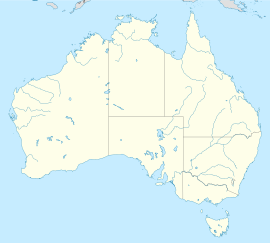Mount Barney National Park
Mount Barney National Park Error: |state= not defined (help) | |
|---|---|
 | |
| Coordinates | 28°13′14″S 152°41′42″E / 28.22056°S 152.69500°E |
| Established | 6 September 1947 |
| Area | 130.0 km² |
Error: |type= not defined (help) | |
Mount Barney National Park is a national park in Queensland (Australia), 90 km southwest of Brisbane. Mounts Barney, Maroon, May and Lindesay rise majestically above the surrounding farmlands in Mount Barney National Park on the Queensland/New South Wales border. These rugged peaks are the remains of the ancient Focal Peak Shield Volcano which erupted 24 million years ago. Mount Barney (1359m) is the second highest peak in south-east Queensland and has some very rare and unique plants. The town of Rathdowney is closest, 15 km to the northeast. This spectacular park became part of the World Heritage Gondwana Rainforests of Australia (formerly known as the Central Eastern Rainforest Reserves) in 1994.

The park is dominated by the grand twin peaks of Mount Barney. Surrounding these peaks are numerous mountains, steep valleys, caves, deep rock pools and lots of woodland forest. The park also contains the peaks of Mount Ballow, Mount Ernest, Mount Maroon and Mount May. Mount Barney National Park amalgamated the adjacent Mount Lindesay National Park in 1980.
Accommodation

Bush camping is allowed at Mount May and Mount Barney. Restrictions apply during peak holiday times. Book your campsite at least three weeks before your visit. You can also camp nearby in private campgrounds at Flanagans Reserve (near Yellow Pinch), Bigriggen and Mt Barney Lodge.
Flora and fauna
Visitors to the park may notice the abundant birdlife due to their bird songs. A few playful platypus live in the park. The park has extremely varied vegetation with open forests around the foothills of the peaks, subtropical rainforest above 600m, montane heath shrublands towards the summit of the peaks, cool temperate rainforest on the summit of Mount Ballow, and mallee eucalypt shrublands on Mount Maroon. Many rare and unusual plant species grow in the park including the endangered Maroon wattle Acacia saxicola, and the rare mallee eucalypt Eucalyptus codonocarpa, Mount Barney bush pea Pultanaea whiteana and Eucalyptus michaeliana. The rainforest on Mount Barney provide critical habitat for the plumed frogmouth Podargus ocellatus plumiferus. This primitive bird species is listed as vulnerable to extinction.[1]
Recreation
There are expansive views over the border ranges and scenic rim forests from the summit of Mount Barney. The mountain is an old bushwalking destination by Australian standards and more than 30 routes lead to the summits of its East and West peaks. The majority of routes are not maintained by the Queensland State government and therefore navigational skills are mandatory, especially for first time visitors. The most challenging routes up Mount Barney include Logans Ridge and Short Leaning Ridge. Peasants or South Ridge is a better choice for less experienced climbers. Allow plenty of time for the ascent and descent, which take between 8 and 10 hours, depending on the route and level of fitness. Walkers need navigational and bushwalking skills and sound physical fitness. It is not unusual to meet climbers at all hours of the day and night, however prior knowledge of the area is required.
A popular alternative to going up and down South Ridge is to ascend via South East Ridge and descend via South Ridge. Navigational equipment or local knowledge are required for this route. The benefit of ascending via South East Ridge is that the track incorporates the East Peak. From the East Peak the track drops down into the saddle area at the base of the West Peak. The West Peak can be incorporated into this walk at an additional 2km (allow 2 hours). Allow 8-10 hours for the South East Ridge return South Ridge route with an above average degree of civilian fitness and carrying an 6-8kg day pack. A minimum of 4 litres of water should be carried per adult. Seasonal water is available from a small creek in the saddle area however this should not be relied upon.
Nearby Mount Maroon is popular for rockclimbing. The first known climb to the summit by a European was completed in 1828 by Captain Patrick Logan, by one of the hardest and spectacular ridges on the mountain, named in his honour. Allan Cunningham and Charles Fraser were also in his company, however they did not reach the summit.
Mount Barney is a wilderness area and should be given appropriate respect. Failure to prepare and follow the principles of bushwalking could result in an unfavourable outcome.

